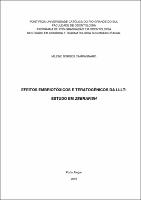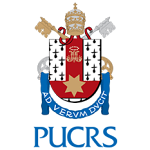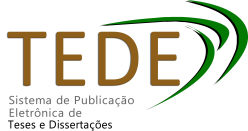| Compartilhe o registro |


|
Use este identificador para citar ou linkar para este item:
https://tede2.pucrs.br/tede2/handle/tede/6798| Tipo do documento: | Dissertação |
| Título: | Efeitos embriotóxicos e teratogênicos da LLLT : estudo em zebrafish |
| Autor: | Campagnaro, Milene Borges  |
| Primeiro orientador: | Weber, João Batista Blessmann |
| Resumo: | A laserterapia de baixa intensidade (LLLT/Low-Level Laser Therapy) tem sido amplamente utilizada na Odontologia, tendo em vista seus efeitos locais e sistêmicos, terapêuticos e biomodulatórios sobre os tecidos. Assim, o objetivo deste estudo foi avaliar a embriotoxicidade, a teratogênese e as alterações sistêmicas provocadas pela LLLT, utilizando um laser de diodo (GaAlAs) infravermelho (ʎ830nm, 90mW, CW) e vermelho (ʎ685nm, 30mW, CW), sobre o desenvolvimento inicial de embriões de Zebrafish. Para isso, foram utilizados 1560 embriões, acompanhados desde a fecundação até o 5dpf. Foram realizadas ao longo dos cinco dias de acompanhamento, a avaliação das taxas de eclosão, embriotoxicidade e sobrevivência. As análises como batimento cardíaco, comportamento exploratório, comportamento aversivo, técnica da calceína e técnica do alcian blue foram realizadas somente no final do experimento, no 5dpf. Os animais foram divididos em três grupos. Um grupo com 140 animais e sem aplicação de laser serviu como controle (Ctrl) e dois grupos experimentais, foram irradiados com laser Infra-vermelho (IR) ou com laser Vermelho(R), ambos com 710 animais. Os grupos IR e R foram subdivididos em cinco subgrupos conforme as densidades de energia recebidas: 0.5J, 1.0J, 2.0J, 4.0J, 8.0J, com142 animais em cada subgrupo. Foram realizadas três sessões de laserterapia, no 1°, 3° e 5°dpf, de acordo com os parâmetros de cada dose utilizada. Os resultados obtidos na presente pesquisa demonstram que nos grupos em que o laser foi aplicado, houve um retardo na eclosão, uma maior mortalidade e presença de alterações teratogênicas dos animais, bem como alterações comportamentais, quando comparados com o grupo controle. Os valores para os batimentos cardíacos foram maiores para os grupos R e IR, quando comparados com o grupo controle, sendo que o grupo IR apresentou os maiores valores. A formação cartilaginosa e óssea não apresentou alterações qualitativas visualmente perceptíveis, se mantendo no padrão de normalidade. |
| Abstract: | The low-level laser therapy (LLLT) has been widely used in Dentistry, considering its local and systemic effects as well as its therapeutic and biomodulatory action on the tissues. Therefore, the aim of this study was to evaluate the embryotoxicity, teratogenesis and systemic alteration caused by LLLT, using a diode laser (GaAlAs) with infrared (ʎ830nm, 90mW, CW) and red (ʎ685nm, 30mW, CW) wavelengths, in the initial development of the Zebrafish embryos. For this, 1560 embryos, monitored from fecundation to 5 dpf, were used and the eclosion, embryotoxicity, and survival rates, were measured. The analysis of the heartbeat, exploratory and aversive behavior, calcein and alcian blue techniques were realized only in the end of the experiment, with 5 dpf. The animals were divided in three groups. One control group (Ctrl) with 140 animals without LLLT, and two experimental groups, with 710 animals each, irradiated with infrared laser (IR) or red laser (R). The experimental groups were subdivided in five subgroups according to the energy densities of energy received (0.5J, 1.0J, 2.0J, 4.0J, 8.0J) with 142 animals in each subgroups. The LLLT was performed in the first, second and fifth dpf, according to the stipulated parameters. The results obtained in the present study showed that in groups with LLLT, there was a delay in the eclosion, a higher mortality rate and the presence of teratogenic Changes in the animals, as well as behavioral alterations, when compared to control group. The heartbeat was higher in both IR and R groups, when compared to the control group, with the IR group sowing the highest values. The cartilage and bone formation didn’t show any visually alterations, keeping the normality standards. |
| Palavras-chave: | LASER (ODONTOLOGIA) TECIDO ÓSSEO TRAUMATOLOGIA BUCOMAXILOFACIAL ODONTOLOGIA |
| Área(s) do CNPq: | CIENCIAS DA SAUDE::ODONTOLOGIA |
| Idioma: | por |
| País: | Brasil |
| Instituição: | Pontifícia Universidade Católica do Rio Grande do Sul |
| Sigla da instituição: | PUCRS |
| Departamento: | Faculdade de Odontologia |
| Programa: | Programa de Pós-Graduação em Odontologia |
| Tipo de acesso: | Acesso Aberto |
| URI: | http://tede2.pucrs.br/tede2/handle/tede/6798 |
| Data de defesa: | 11-Mar-2016 |
| Aparece nas coleções: | Programa de Pós-Graduação em Odontologia |
Arquivos associados a este item:
| Arquivo | Descrição | Tamanho | Formato | |
|---|---|---|---|---|
| DIS_MILENE_BORGES_CAMPAGNARO_PARCIAL.pdf | Texto Parcial | 1,04 MB | Adobe PDF |  Baixar/Abrir Pré-Visualizar |
Os itens no repositório estão protegidos por copyright, com todos os direitos reservados, salvo quando é indicado o contrário.




